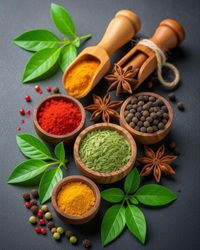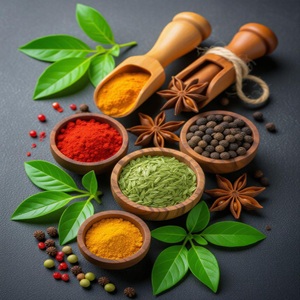Herbs and Spices
For over 6,000 years, herbs have been humanity’s trusted allies in healing, bridging ancient traditions and modern medicine. From the fertile valleys of Mesopotamia to contemporary laboratories, herbs like garlic, ginger, turmeric, and chamomile have shaped health practices across cultures, addressing ailments from infections to cognitive decline.
Dementia Hub explores 20 common herbs and spices to allow you to make informed choices and decisions based on science and factual studies.
Herbs and Spices
For over 6,000 years, herbs have been humanity’s trusted allies in healing, bridging ancient traditions and modern medicine. From the fertile valleys of Mesopotamia to contemporary laboratories, herbs like garlic, ginger, turmeric, and chamomile have shaped health practices across cultures, addressing ailments from infections to cognitive decline.
Dementia Hub explores 20 common herbs and spices to allow you to make informed choices and decisions based on science and factual studies.


Since mankind first started walking herbs and spices have been more than just culinary delights - they’ve been nature’s pharmacy, revered for their healing properties across cultures and continents. From ancient civilizations to modern herbalism, these plants have shaped medicine, rituals, and wellness practices worldwide. Often forgotten in a world of pharma, Dementia Hub dives into the various types of herbs to help you make informed decisions based on factual science.


The use of herbs and spices for medicinal purposes dates back to prehistoric times. Archaeological evidence suggests that Neanderthals used plants like chamomile and yarrow for their soothing effects as early as 60,000 years ago.


In ancient Egypt, around 3,000 BC, herbs like garlic, coriander, and frankincense were documented in medical papyri, such as the Ebers Papyrus, for treating infections, digestive issues, and even embalming. Spices like cumin and myrrh were prized not only for health benefits but also for their spiritual significance.


By 2,000 BC, sophisticated medical traditions emerged. In Mesopotamia, healers used licourice root and fennel to treat respiratory and digestive ailments. Ancient China developed Traditional Chinese Medicine (TCM), incorporating herbs like ginseng, ginger, and licourice to balance the body’s qi (energy).
India’s Ayurvedic system, dating back to 1,500 BC, relied on turmeric, ashwagandha, and cardamom to promote vitality and treat inflammation. These systems viewed herbs and spices as holistic remedies, addressing both physical and spiritual health.


In ancient Greece and Rome, physicians like Hippocrates and Galen elevated herbal medicine into a science. Hippocrates, the “father of medicine,” prescribed herbs like thyme and peppermint for respiratory and digestive issues. Galen’s treatises on herbal remedies influenced European medicine for centuries. Spices like saffron and cinnamon, traded along the Silk Road, were valued as much for their rarity as for their ability to treat fevers and infections.


During the Middle Ages, monasteries in Europe preserved herbal knowledge, cultivating gardens of sage, rosemary, and lavender for remedies. Meanwhile, the Islamic Golden Age (8th–13th centuries) advanced pharmacology. Scholars like Avicenna documented the medicinal uses of cloves, nutmeg, and black pepper in texts like The Canon of Medicine, which became a cornerstone of medieval medicine. Spices were so valuable they were often worth more than gold, used to treat everything from plague to melancholy.


The spice trade, peaking in the 15th–17th centuries, transformed medicine by introducing New World plants like chili peppers and vanilla to Europe, Asia, and Africa. European apothecaries blended these with Old World staples like basil and oregano, creating new remedies. Indigenous cultures in the Americas used herbs like echinacea and cacao for immunity and energy, contributing to a global exchange of medicinal knowledge.


The 19th and 20th centuries saw a split between traditional herbalism and modern pharmaceuticals, yet herbs and spices remained vital. Scientists began isolating active compounds, like curcumin in turmeric for anti-inflammatory effects or capsaicin in chili peppers for pain relief. Today, herbal medicine is experiencing a renaissance, with research validating ancient practices. Ginger is studied for nausea relief, while rosemary and sage show promise for cognitive health.


From ancient shamans to modern laboratories, herbs and spices have been humanity’s allies in health and healing. Their journey through history reflects our enduring quest to understand nature’s remedies. Whether brewed in a tea, sprinkled in a dish, or studied in a lab, these plants continue to inspire wellness and wonder.
Explore the power of herbs and spices in your own life and discover their timeless benefits!


Since mankind first started walking herbs and spices have been more than just culinary delights - they’ve been nature’s pharmacy, revered for their healing properties across cultures and continents. From ancient civilizations to modern herbalism, these plants have shaped medicine, rituals, and wellness practices worldwide. Often forgotten in a world of pharma, Dementia Hub dives into the various types of herbs to help you make informed decisions based on factual science.
The use of herbs and spices for medicinal purposes dates back to prehistoric times. Archaeological evidence suggests that Neanderthals used plants like chamomile and yarrow for their soothing effects as early as 60,000 years ago.
In ancient Egypt, around 3,000 BC, herbs like garlic, coriander, and frankincense were documented in medical papyri, such as the Ebers Papyrus, for treating infections, digestive issues, and even embalming. Spices like cumin and myrrh were prized not only for health benefits but also for their spiritual significance.
By 2,000 BC, sophisticated medical traditions emerged. In Mesopotamia, healers used licourice root and fennel to treat respiratory and digestive ailments. Ancient China developed Traditional Chinese Medicine (TCM), incorporating herbs like ginseng, ginger, and licourice to balance the body’s qi (energy).
India’s Ayurvedic system, dating back to 1,500 BC, relied on turmeric, ashwagandha, and cardamom to promote vitality and treat inflammation. These systems viewed herbs and spices as holistic remedies, addressing both physical and spiritual health.
In ancient Greece and Rome, physicians like Hippocrates and Galen elevated herbal medicine into a science. Hippocrates, the “father of medicine,” prescribed herbs like thyme and peppermint for respiratory and digestive issues. Galen’s treatises on herbal remedies influenced European medicine for centuries. Spices like saffron and cinnamon, traded along the Silk Road, were valued as much for their rarity as for their ability to treat fevers and infections.
During the Middle Ages, monasteries in Europe preserved herbal knowledge, cultivating gardens of sage, rosemary, and lavender for remedies. Meanwhile, the Islamic Golden Age (8th–13th centuries) advanced pharmacology. Scholars like Avicenna documented the medicinal uses of cloves, nutmeg, and black pepper in texts like The Canon of Medicine, which became a cornerstone of medieval medicine. Spices were so valuable they were often worth more than gold, used to treat everything from plague to melancholy.
The spice trade, peaking in the 15th–17th centuries, transformed medicine by introducing New World plants like chili peppers and vanilla to Europe, Asia, and Africa. European apothecaries blended these with Old World staples like basil and oregano, creating new remedies. Indigenous cultures in the Americas used herbs like echinacea and cacao for immunity and energy, contributing to a global exchange of medicinal knowledge.
The 19th and 20th centuries saw a split between traditional herbalism and modern pharmaceuticals, yet herbs and spices remained vital. Scientists began isolating active compounds, like curcumin in turmeric for anti-inflammatory effects or capsaicin in chili peppers for pain relief. Today, herbal medicine is experiencing a renaissance, with research validating ancient practices. Ginger is studied for nausea relief, while rosemary and sage show promise for cognitive health.
From ancient shamans to modern laboratories, herbs and spices have been humanity’s allies in health and healing. Their journey through history reflects our enduring quest to understand nature’s remedies. Whether brewed in a tea, sprinkled in a dish, or studied in a lab, these plants continue to inspire wellness and wonder.
Explore the power of herbs and spices in your own life and discover their timeless benefits!








